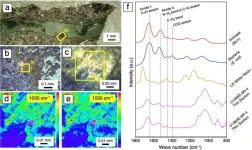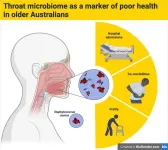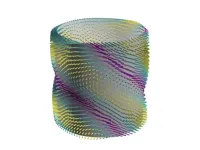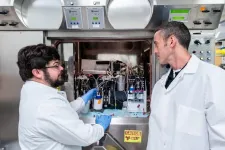The chances of anything coming from Mars
New method to detect life makes Mars sample return protocols rock solid
2025-03-06
(Press-News.org)
Within the next decade, space agencies plan to bring samples of rock from Mars to Earth for study. Of concern is the possibility these samples contain life, which could have unforeseen consequences. Therefore, researchers in this field strive to create methods to detect life. For the first time, researchers, including those from the University of Tokyo and NASA, successfully demonstrated a method to detect life in ancient rocks analogous to those found on Mars.
We’ve all seen the movies, in which “Scientists bring back something from space, with disastrous consequences,” or with some similar premise. The idea makes for a fun story, but the idea of microbial aliens contaminating the Earth is based on genuine concerns, and is also nothing new. Back in the days of the Apollo program, on their return, the lucky astronauts who stepped foot on lunar soil underwent decontamination procedures and even quarantines, just in case. More recently, all eyes are on Mars, as multiple sample return missions are being planned.
In order to ensure that samples from Mars cannot contaminate Earth life, the international Committee on Space Research (COSPAR) developed the sample safety assessment framework, essentially a set of protocols for those involved in obtaining, transporting and analyzing Mars rocks, to avoid contamination. A key component of this is our ability to detect the presence or absence of life in a sample. The issue of course being, we haven’t actually got any. To plug this gap, Associate Professor Yohey Suzuki from the Department of Earth and Planetary Science at the University of Tokyo, and his international team, looked at ancient microbe-rich Earth rocks analogous to the kind of Mars rocks we might expect to receive from the red planet in the coming years.
“We first tested conventional analytical instruments, but none could detect microbial cells in the 100-million-year-old basalt rock we use as the Martian analogue. So, we had to find an instrument sensitive enough to detect microbial cells, and ideally in a nondestructive way, given the rarity of the samples we may soon see,” said Suzuki. “We came up with optical photothermal infrared (O-PTIR) spectroscopy, which succeeded where other techniques either lacked precision or required too much destruction of the samples.”
O-PTIR works by shining infrared light onto prepared samples to analyze; in this case, the rocks had their outer layers removed and were cut into slices. While slightly destructive, it leaves plenty of material intact for other kinds of analyses, or even those we have not come up with. This essence of preservation for the future also took place with samples from the moon landings. A green laser then picks up signals from the sample where it was exposed to infrared light. With this, researchers can image details as small as half a micrometer, which is enough to discern when a structure is part of something living.
“We demonstrated our new method can detect microbes from 100-million-year-old basalt rock. But we need to extend the validity of the instrument to older basalt rock, around 2 billion years old, similar to those the Perseverance rover on Mars has already sampled,” said Suzuki. “I also need to test other rock types such as carbonates, which are common on Mars and here on Earth often contain life as well. It’s an exciting time to work in this field. It might only be a matter of years before we can finally answer one of the greatest questions ever asked.”
###
Journal article:
Yohey Suzuki, Mariko Koduka, Frank E. Brenker, Tim Brooks, Mihaela Glamoclija, Heather V. Graham, Thomas L. Kieft, Francis M. McCubbin, Mark A. Sephton and Mark A. van Zuilen, “Submicron-scale detection of microbes and smectite from the interior of a Mars-analogue basalt sample by opticalphotothermal infrared spectroscopy”, International Journal of Astrobiology, http://doi.org/10.1017/S1473550425000011
Funding: Y. S. was supported by the Astrobiology Center Program of National Institutes of Natural Sciences (NINS) (AB0502). M. A. S. was supported by UK Space Agency grants ST/V002732/1 and ST/V006134/1.
Useful links:
Department of Earth and Planetary Science - https://www.eps.s.u-tokyo.ac.jp/en/
Graduate School of Science - https://www.s.u-tokyo.ac.jp/en/index.html
Research contact:
Associate Professor Yohey Suzuki
Department of Earth and Planetary Science, The University of Tokyo,
7-3-1 Hongo, Bunkyo-ku, Tokyo, 113-0033, Japan
yohey-suzuki@eps.s.u-tokyo.ac.jp
Press contact:
Mr. Rohan Mehra
Public Relations Group, The University of Tokyo,
7-3-1 Hongo, Bunkyo-ku, Tokyo, 113-8656, Japan
press-releases.adm@gs.mail.u-tokyo.ac.jp
About The University of Tokyo:
The University of Tokyo is Japan's leading university and one of the world's top research universities. The vast research output of some 6,000 researchers is published in the world's top journals across the arts and sciences. Our vibrant student body of around 15,000 undergraduate and 15,000 graduate students includes over 4,000 international students. Find out more at www.u-tokyo.ac.jp/en/ or follow us on X (formerly Twitter) at @UTokyo_News_en.
END
[Attachments] See images for this press release:

ELSE PRESS RELEASES FROM THIS DATE:
2025-03-06
A new discovery about how tiny protein clusters form in cells could pave the way for treatments for Emery-Dreifuss muscular dystrophy (EDMD), a rare genetic disorder that causes muscle weakness and heart problems.
Researchers at the USC Dornsife College of Letters, Arts and Sciences combined advanced imaging techniques and theoretical physics to observe and explain how nanoclusters of the protein emerin form inside living cells. These clusters — about 100,000 times smaller than a human hair’s width — play a crucial role in how cells sense and respond to mechanical forces like stretching or pressure, ...
2025-03-06
Kidney transplant recipients with type 2 diabetes treated with a new class of anti-obesity drugs were less likely to experience organ failure and survived longer, a new study shows. Not only is obesity a known risk factor for diabetes, but it also increases risk of postsurgical complications, such as inflammation, organ rejection, and early death.
Previous research had suggested some benefit for kidney transplant recipients with a history of type 2 diabetes who took the medications, originally designed to treat diabetes, at some point after their transplant ...
2025-03-06
By 2050, there will be 25.2 million people living with Parkinson’s disease worldwide (a 112% increase from 2021), largely due to population ageing, suggests a modelling study published by The BMJ today.
Overall, the number of people living with Parkinson’s disease (all age prevalence) per 100,000 population is predicted to increase by 76%, and by 55% when corrected for age differences (age standardised prevalence), with rates projected to be highest in East Asia.
The researchers say these projections “could serve as an aid in promoting health research, ...
2025-03-06
New research by Flinders University has uncovered a potential marker that could provide valuable insights into the overall health of older adults living in long-term aged care facilities.
Led by PhD candidate Sophie Miller in the College of Medicine and Public Health, the study found that a simple swab from the back of the throat, known as the oropharynx, may offer clues about health challenges faced by aged care residents.
“Our findings suggest that certain bacteria detected in the back of the throat could indicate greater health vulnerability in older adults,” says Miller.
Identifying vulnerable individuals ...
2025-03-06
A common type of diabetes medication could help cancer patients make a better long-term recovery, according to new research from the University of East Anglia.
Many cancer patients go on to develop heart failure - because of the cancer itself and also due to chemotherapy. This can lead to a reduced quality of life, multiple admissions to hospital or even death.
But a new study published today shows that a type of diabetes medication, called an SGLT2 inhibitor, may help protect the ...
2025-03-05
A new seismic study of Singapore could guide urban growth and renewable energy development in the coastal city nation, where 5.6 million residents live within an area of 734 square kilometers.
The study, published in Seismological Research Letters, identifies areas with increased risk of ground shaking and a possible reservoir for geothermal energy production, as well as a glimpse at Singapore’s tectonic history.
Jiayuan Yao of China University for Geosciences and colleagues analyzed teleseismic data captured by a few permanent seismic stations and a nodal seismic array deployed in 2019 around the city. Their results provide the first detailed look at the top-kilometer ...
2025-03-05
When mechanical and structural engineers design machines, bridges, and buildings, they calculate loads, stresses, and deformation of metal, steel, concrete, glass, wood, and plastic to find the optimal geometry that bears loads with the minimum cost of material.
Designing for relatively hard materials that do not deform too much is commonly handled by software that calculates and optimizes structures using mathematical models that are well understood and easily applied.
But there is an expanding class of design challenges for things that incorporate soft materials—biological materials, engineered tissues, membranes, and even shape-shifting ...
2025-03-05
Positron emission tomography (PET) is a nuclear imaging technique used to diagnose conditions such as cancer. An innovative advance from scientists at St. Jude Children’s Research Hospital is enhancing the technique’s ability to check for signs of neurological disease. The researchers repurposed the drug edaravone, an antioxidant used to treat amyotrophic lateral sclerosis (ALS), as a probe to be used with central nervous system PET imaging. With this technique, the researchers can ...
2025-03-05
At the height of the COVID-19 pandemic, hospitals frequently ran short of beds in intensive care units. But even earlier, ICUs faced challenges in keeping beds available. With an aging American population, 11% of hospital stays included ICU stays.
Artificial intelligence offers a possible solution, says Indranil Bardhan, professor of information, risk, and operations management and Charles and Elizabeth Prothro Regents Chair in Health Care Management at Texas McCombs. AI models can predict the lengths of time patients will spend in the ICU, helping hospitals better manage their beds and, ideally, cut costs.
But although AI is good at predicting length of stay, ...
2025-03-05
For an abdominal wall hernia repair, also known as a ventral hernia repair, the most common surgical approaches have been laparoscopic and open techniques.
But a new approach for repairing hernias has been steadily growing in popularity: the surgical robot.
Supporters of using the robot method state multiple advantages over traditional laparoscopic and open approaches, including improved surgeon ergonomics.
But there may be downsides to the technology that are going undiscussed.
In a research article published in JAMA Surgery, Brian Fry, M.D., M.S., a ...
LAST 30 PRESS RELEASES:
[Press-News.org] The chances of anything coming from Mars
New method to detect life makes Mars sample return protocols rock solid



